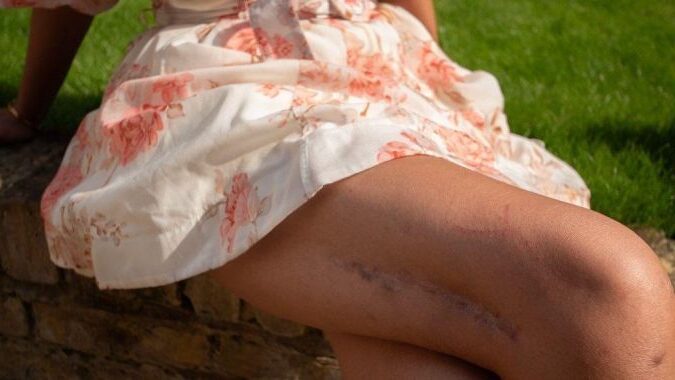BTN News: Elaine Foo’s life took a dramatic turn after undergoing leg lengthening surgery in London in 2016—a decision driven by a deep-seated desire to be taller. What she hoped would be a transformative experience ended in a series of painful complications, leaving her with lasting physical and psychological scars. At 49, Foo has endured five surgeries, three bone grafts, and a lengthy legal battle against her surgeon, all while grappling with the trauma of a procedure that went terribly wrong. Foo’s story highlights the risks and challenges of elective surgeries, especially when compounded by body dysmorphia and the pursuit of unattainable beauty standards.
1. “A Price Too High”: The Cost of Leg Lengthening Surgery Gone Wrong
Elaine Foo’s journey began with an intense desire to increase her height. From a young age, Foo struggled with her stature, feeling that being taller would bring her more opportunities and beauty. The obsession grew until, in her mid-20s, she came across an article on leg lengthening surgery. Despite the risks—described vividly as medieval-looking devices and rampant infections—Foo was captivated by the idea.
Sixteen years later, Foo found a clinic in London offering the surgery she had long considered. Under the care of orthopedic surgeon Jean-Marc Guichet, she opted for the procedure, hoping to grow from her natural height of 1.57 meters to 1.65 meters. She paid nearly £50,000 ($64,000) to undergo the surgery in July 2016, believing the high cost would guarantee the best care and results.
2. The Reality of Leg Lengthening: “My Legs Felt Like They Were on Fire”
The leg lengthening procedure involves breaking the bones of the legs and inserting a metal rod that gradually extends to increase height. Foo’s initial post-surgery period was marked by intense pain. “It felt like someone was roasting my legs from the inside,” she recalls. Despite these agonizing sensations, Foo persevered, determined to see the process through.
However, just two weeks into the procedure, disaster struck. Foo heard a crunch in her left leg—a sound she described as similar to snapping a chocolate bar—and immediately felt excruciating pain. A scan revealed that the metal rod had pierced her femur, the strongest bone in the human body. Foo’s dreams of recovery were dashed, but her doctor remained optimistic, suggesting they pause the left leg’s treatment and continue with the right.
3. Mounting Complications: “I Lost the Best Years of My Life”
The complications did not end there. Foo’s right leg reached its desired length, but scans soon showed a lack of bone growth. Her femur was split into two pieces, held together only by the metal rod. In April 2017, a new round of surgeries began in Milan to address these issues. But the challenges persisted—a broken rod, painful recovery, and mounting costs. Foo’s communication with Dr. Guichet deteriorated, and she found herself struggling to find alternative medical advice.
By July 2017, she sought help from a specialist within the NHS, who warned her of a long road to recovery—at least five more years of treatment to heal fully. Foo describes the years following her surgery as isolating, filled with financial hardship, physical disability, and emotional trauma.
4. Legal Battle and Psychological Aftermath: “A Journey Through Fire”
The physical pain was just one aspect of Elaine Foo’s ordeal; the emotional and psychological consequences were equally devastating. Foo, who believes she has body dysmorphia, found herself facing a mental health crisis. From 2017 to 2020, she lived in near-total isolation, unemployed, single, and financially drained. Foo also reported symptoms of post-traumatic stress disorder (PTSD) due to the surgery’s complications and prolonged recovery.
In a bid for justice, Foo filed a legal claim against Dr. Guichet, arguing that the complications were due to medical negligence. The case concluded in July 2023 with a substantial settlement in Foo’s favor, although the doctor admitted no liability. His defense argued that Foo had been warned of the potential risks and that her bone regeneration issues were exacerbated by her undisclosed use of antidepressants and extending the rod beyond agreed lengths.
5. Reflections on a Painful Choice: “No, Thank You”
Reflecting on her decision, Foo admits that she now regrets undergoing the surgery. “If someone asked me today if I would do it again, knowing what I know now, I’d say, ‘No, thank you,'” she states firmly. Foo hopes her story will serve as a warning to others who may be considering similar elective procedures. “I lost the best years of my life,” she adds, underscoring the unforeseen costs—financial, physical, and emotional—that accompanied her quest for a few extra inches in height.
6. Understanding Body Dysmorphia and Its Role in Foo’s Decision
Elaine Foo believes her decision was heavily influenced by body dysmorphia, a mental health disorder where individuals see perceived defects in their appearance that others might not notice. For Foo, being taller equated to being better, more beautiful, and more successful. “When you’re dealing with body dysmorphia, there’s no rational explanation for why you feel so overwhelmingly inadequate,” she explains. Foo’s case is a poignant reminder of how mental health struggles can drive people toward drastic, sometimes dangerous decisions.
7. Lessons Learned and Moving Forward: A Call for Caution
Eight years after her initial surgery, Foo is still on the road to recovery. Her experience serves as a cautionary tale about the risks of elective surgeries and the importance of thoroughly understanding potential complications. While Foo has reached a legal resolution, her physical and psychological recovery continues. She now encourages others to think carefully before opting for such procedures, advocating for more awareness around body dysmorphia and its impact on self-perception.
Conclusion:
Elaine Foo’s story of a leg lengthening surgery gone wrong illustrates the profound physical, emotional, and financial toll of elective procedures, especially when driven by underlying mental health conditions like body dysmorphia. Her painful journey underscores the importance of weighing risks carefully and seeking comprehensive mental health support before making life-changing medical decisions.


